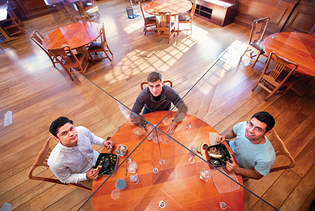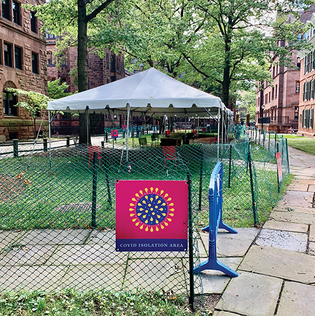
Bob Handleman
Enjoying a meal in Silliman College, with some added protection, are (left to right) Jesus Contreras Magana ’21, Maciej Zielonka ’21, and Edwin Ruiz Fuentes ’22.
View full image

Mark Alden Branch ‘86
Welch and Bingham Halls are being used as an isolation area for students who test positive.
View full image
It’s been a fall of firsts and unknowns at Yale, as the pandemic reshaped university life. In mid-October, just over a week after lowering its alert level to green (lower risk), the university raised it back to yellow (low to moderate risk), when 18 of the 26 men’s ice hockey players tested positive for the coronavirus. In quick succession, in-person workouts were suspended, athletic facilities were closed for thorough cleaning, and the Art Gallery and Center for British Art shut their recently reopened doors until further notice. According to the Yale COVID dashboard, from August 1 to October 15 Yale reported 58 positive tests across the university, including among graduate and professional students, staff, and faculty. The hockey cluster made up nearly a third of those 58.
That news came in the middle of a semester otherwise noteworthy for the gradual reopening of the campus to students. The 1,821 Yale College students living on campus (as against 5,100 in a typical year) had emerged from quarantines in their dorms in mid-September. (Most graduate and professional students are living off campus, as usual.) Students could start going to the Yale libraries and Payne Whitney gym in limited numbers, and could sit down to eat in their reconfigured dining halls—instead of picking up boxes of take-out, the only option available earlier in the month. They could also visit local restaurants, as long as they abided by state COVID protocols: masks except when eating and drinking, mostly outdoor dining, social distancing, and lots of hand-washing.
All over campus, signs with the “Healthy Yale” logo have been put up to inform people what’s open, what isn’t, and what the protocols are. And every student had signed Yale’s “Community Compact.” It requires them to commit “to contributing to campus life in a way that will promote the health and safety of all community members.” The compact also lists several of the protocols, including regular testing, mask wearing, and limiting the size of gatherings. Students who flout the protocols may be required to leave campus.
Fausto Hernandez ’21 has continued getting most of his dining hall food to go. He compares the redesigned dining hall tables, with their new plexiglass dividers, to “ice trays with tables underneath.” But he says his friends are all “impressed by the logistical efforts.” One of relatively few seniors who chose to live on campus, Hernandez says that even the biweekly COVID tests in the Davenport common room aren’t a big deal. “You step into a ventilated booth, and a person on the other side of the window holds a mirror so you can use a cotton swab to swab your nose. Then you deposit it in a test tube on the way out,” says Hernandez, and adds, “It’s quite amazing.”
Then there are the remote classes. While about five percent of undergraduate classes, mostly in the sciences and the arts, are being held in person, the vast majority of classes are virtual. Over the summer, Yale’s Poorvu Center for Teaching and Learning helped prepare 1,200 members of the faculty, teaching fellows, and academic staff for the virtual world. “Sometimes you feel a tiny bit silly debating high-level philosophy when you’re sitting there in your pajamas,” says Honor McCarthy ’22, who is living off campus in New Haven this year.
Most of Yale’s graduate and professional schools are offering some in-person classes—perhaps 20 percent of all courses, with the rest online. Graduate programs in the sciences have largely reopened their research facilities, though they continue to limit numbers. School of Nursing students who enrolled in virtual classes were sent kits they could work with at home. First-year medical students started the year mostly with online teaching, but Michael L. Schwartz, the med school’s associate dean for curriculum, says there will be more in-person sessions on clinical skills and anatomy dissection as the semester progresses. Second-years started the year with a mix of in-person and remote; Schwartz expects more in-person work as they prepare for clinical rotations in the spring.
Clubs, senior societies, and cultural and religious houses have moved their scheduled activities online. Dwight Hall programs are also taking place almost entirely online, and the building is temporarily home to a COVID testing center and a storeroom for packages sent to Old Campus addresses.
As restrictions loosened post-quarantine, however, some students looked for ways to set up actual gatherings. Outdoor get-togethers—socially distanced and masked—started picking up in early fall, though whether they’ll withstand the Connecticut winter remains to be seen. Many senior societies are conducting their meetings online.
Arts groups are holding on. The Yale College Singing Group Council postponed rush for what may be the first time since the council was created in the 1980s. Still, there’s “a lot of positive energy,” says Kate Krier, Yale College associate dean for the arts. Singing groups are holding online jam sessions, and the Yale Symphony, Bands, and Glee Club are all finding ways to work virtually. Other students are coordinating virtual choirs, book groups, online musicals, and dance performances. One team hopes to produce a Zoom version of the Rocky Horror Picture Show. And the School of Music worked with Zoom and other music schools to enhance the platform for online music lessons.
“It’s a bit of a weird year, but closer to normal than I would have anticipated,” says Pericles Lewis, vice provost for academic initiatives. As a comparative literature professor, he’s also teaching one of the few courses in which people actually gather for class: Purposes of a College Education. It’s a 60-plus-student lecture held in a hall that seats 300. (It was originally created for international students who might not have been granted student visas if they weren’t taking an in-person class.) “It’s a little bit funny to lecture to people all in masks; you can’t tell what their facial expression is,” says Lewis. But, he adds, it’s gotten easier over time.
“There were a lot of hiccups,” says Chika Ogbejesi ’21. But she’s found some bright spots. In her neurobiology class, she prefers asking questions via Zoom’s chat feature over asking them in person.
First-years head home in mid-November and won’t return to campus until fall ’21. The sophomores—who enrolled remotely this semester—will return to campus next term, which begins February 1. And spring break has been canceled for everyone, to minimize comings and goings from campus; instead, students will be given five separate vacation days, spread throughout the semester.
Meanwhile, concerned parents of high school seniors will be relieved to know that Jeremiah Quinlan ’03, dean of undergraduate admissions, has no plans to change the target number of acceptances. After the pandemic hit, nearly 350 admitted students of the Class of 2024 decided to take ’20–’21 as a gap year—so many that it seemed the admissions target for the Class of 2025 might have to shrink. But Quinlan remains calm. “So, this year’s first-year class was smaller than usual,” he told the Yale Alumni Association. “Next year’s class will be larger. The shift won’t make it harder for students who are applying out of high school this year to be admitted to Yale.”
 loading
loading
